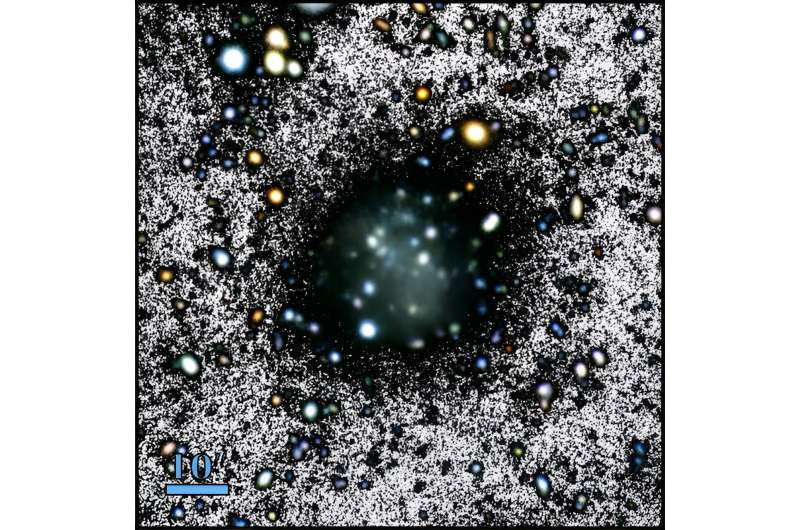October 25, 2023 report
This article has been reviewed according to Science X's editorial process and policies. Editors have highlighted the following attributes while ensuring the content's credibility:
fact-checked
preprint
trusted source
proofread
Astronomers discover new almost dark galaxy

By analyzing deep optical imagery from the IAC Stripe 82 Legacy Project, an international team of astronomers has serendipitously discovered a new almost dark galaxy. The newfound galaxy, dubbed "Nube," has a very low surface brightness and is as massive as the Small Magellanic Cloud (SMC). The finding is reported in a paper published October 18 on the pre-print server arXiv.
Galaxies with central surface brightness fainter than 26 mag/arcsec2 are generally known as "almost dark galaxies." They lack an unambiguous optical counterpart and they are usually missed in the optical catalogs of wide field surveys. However, these faint galaxies may showcase extremely faint optical emission when imaged more deeply.
Now, a team of astronomers led by Mireia Montes of the University of La Laguna, Spain, has detected another galaxy of this rare type. They identified it during a visual inspection of one of the survey fields of the IAC Stripe 82 Legacy Project—a wide-area survey for faint surface brightness astronomy. The survey investigates Stripe 82—a 2.5 degree wide stripe along the Celestial Equator in the Southern Galactic Cap.
Nube is located some 350 million light years away and has an effective surface brightness of approximately 26.75 mag/arcsec2. The galaxy is assumed to be 10 billion years old and its metallicity was measured to be at a level of -1.1.
When it comes to other fundamental parameters of Nube, the study found that it is very extended, with a half-mass radius of 22,500 light years. The galaxy has a stellar mass of about 390 million solar masses and its total halo mass is estimated to be 26 billion solar masses. These results point to an effective surface density of some 0.9 solar masses/parsec2.
Based on the findings, the authors of the paper concluded that Nube is the most massive and extended galaxy of its kind so far detected. The galaxy turned out to be also 10-times fainter and its radius is three-times larger than typical ultra-diffuse galaxies (UDGs) with similar stellar masses. In general, UDGs are extremely-low-density galaxies with sizes comparable to the Milky Way, but have only about 1% as many stars as our home galaxy.
Taking into account the extreme properties of Nube, the researchers discuss the origin and nature of this galaxy. They investigated whether these properties are a result of the original formation of the galaxy, or whether they are due to a later evolutionary process caused by the environment in which it is found.
"To this end, and under the hypothesis that the distribution of stars in Nube is representative of the distribution of the dark matter halo, we found that a soliton-shaped profile (typical of fuzzy dark matter) reproduces the observed distribution of stars very well," the authors of the study concluded.
More information: Mireia Montes et al, An almost dark galaxy with the mass of the Small Magellanic Cloud, arXiv (2023). DOI: 10.48550/arxiv.2310.12231
Journal information: arXiv
© 2023 Science X Network





















